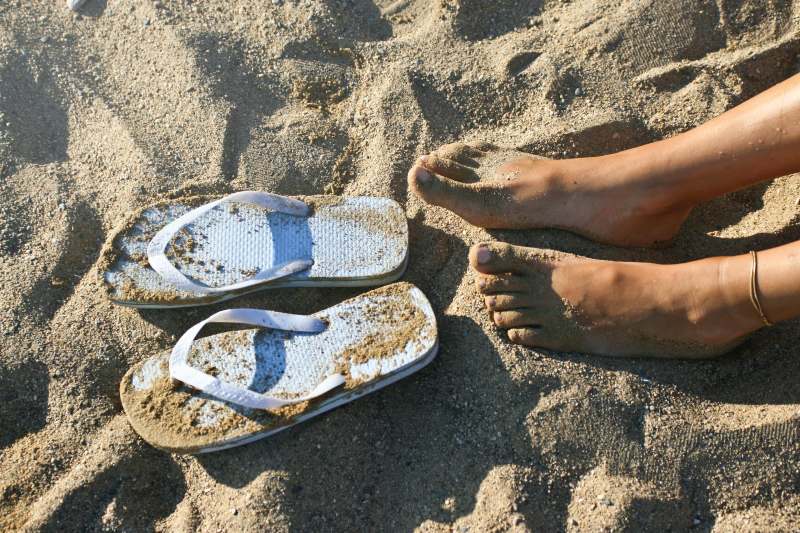Don’t Let the Summer Heat Beat Up Your Feet
Ahh, Summer in Florida has arrived. Time to kick off the work shoes and take a barefoot walk in the grass, maybe a stroll along one of our beaches. As relaxing as that may sound, summertime has the potential to pose foot problems for young and old alike, even more so for those dealing
with diabetes. Here’s the bare-naked truth about rising temperatures and the health of your feet.
Sun Block Shouldn’t Stop at the Ankles
Sunshine and warmer temperatures almost entice us to go barefoot or wear sandals or flip flops at best. When applying sunscreen, don’t forget to protect your two best friends, your feet. Feet are just as susceptible to skin cancer as other areas of your body. Properly fitted footwear for hiking, jogging and walking is important too. Bare feet are magnets for puncture wounds, blisters from hot pavement, and injuries that often accompany doing chores around the house with nothing on to protect your toes and feet. Podiatry Group of Annapolis also points out that outdoor sports in hot temperatures can contribute to the development of fungus issues if socks aren’t properly worn or frequently changed.
If it’s your turn to cut the lawn, take proper foot precautions by wearing protection on your feet. And while the temptation is there to wiggle your toes while manning the grill at a backyard cookout or evening campfire, hot coals and burning embers will take no mercy if they come into contact with bare flesh.
Tri-State Orthopaedics notes some of the most common summer foot injuries can be avoided with a little common sense. “Cute” sandals and flips-flops often come with the sacrifice of foot support and safety so the message here is to sacrifice a little fashion for the sake of your feet.
If you are active in a summer softball league or have little ones starting out in team sports, pay attention to the type of athletic cleats you and the kids wear. The shank of most cleat brands has little in the way of heel support so look for soft, over-the-counter arch supports to avoid growth plate issues and Sever’s Disease. If you are starting a summer work out program don’t skimp on cheap footwear. Even extended walking in worn-out or ill-fitting, or poorly constructed but inexpensive athletic footwear can contribute to foot fractures and tendonitis.
Diabetics: Beware the Ides of Summer
While summer months pose increased risk of foot injuries to almost all, this time of the year brings particular challenges to those dealing with diabetes. Any type of injury or infection can turn minor problems into major medical issues that are complicated by “sensory diabetic neuropathy”—where damaged nerves may prevent your feet from feeling temperatures from hot asphalt or puncture wounds from slivers or stepping on broken glass.

Dr. Eugene Pastorius
Dr. Eugene Pastorius, Brevard Health Alliance Podiatrist, offers some tips on summer safety for your feet, including summer footwear.
“Summertime is when people buy new shoe gear to wear as they head outdoors to enjoy the weather. New shoes sometimes pose a problem due to being too stiff. I suggest having all new shoes properly sized and allow a break-in period until you are used to wearing them.”
Pastorius suggests wearing new shoes initially for an hour per day to see how your feet react to them, then gradually increasing the time worn each day until fully broken in.
“If a new blister does form due to the new footwear, keep the site protected and avoid puncturing blisters with dirty instruments,” he cautions.
“Protect the blister from further damage until it heals. Moleskin as a common product that can be found in stores to help reduce friction and prevent blisters from forming.”
The BHA Podiatrist also suggests that people with diabetes issues closely monitor their summer diets as well.
“Summer also brings a lot of barbeques and family reunions, acknowledges Pastorius.
“A healthy diet during the summer is important in the diabetic population to help prevent small cracks and blisters from worsening into larger problems. Too much sugar (hypoglycemia) can lead to peripheral neuropathy (nerve damage) in patients with Diabetes mellitus.
“Too many sugary drinks or desserts should be avoided.”
Pastorius adds that patients with foot issues should closely monitor their feet during the summer for discolorations, cuts, or any signs of infection.
“Some diabetics have lost “protective sensation” in their feet.
“They should try to avoid being barefoot and should check their feet daily to make sure all of their foot skin is intact. If a diabetic patient can’t see the bottom of their feet, they should use a hand-held mirror or selfie camera on their cell phone for a daily inspection.”
As a final summer precaution, Pastorius encourages any diabetic patients with foot issues to maintain their regular medical check-ups with their primary care physicians, and if patients are deemed “at risk,” to schedule a visit with a podiatrist to development a treatment plan and limit foot health risks and avoid complications.



















































































































































